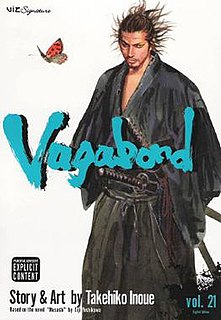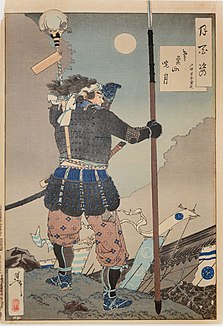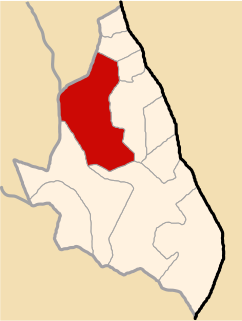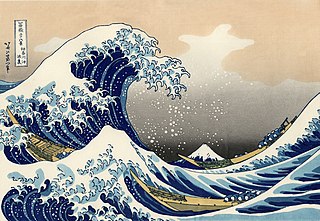
Vagabond is an ongoing Japanese manga series written and illustrated by Takehiko Inoue. It portrays a fictionalized account of the life of Japanese swordsman Miyamoto Musashi, based on Eiji Yoshikawa's novel Musashi.

Iwasa Matabei was a Japanese artist of the early Tokugawa period (1603–1867), who specialized in genre scenes of historical events and illustrations of classical Chinese and Japanese literature, as well as portraits. He was the son of Araki Murashige, a prominent daimyō of the Sengoku period who had been made to commit suicide, leaving Matabei to be raised with his mother's family name, Iwasa. Matabei's work was noted for its distinctive figures, with large heads and delicately drawn features, and he was effective both in colour and monochrome ink-wash painting, using an individual brush technique combining Tosa and Kanō elements.

Sōjutsu (槍術), meaning "art of the spear", is the Japanese martial art of fighting with a Japanese spear.

The Instituto Nacional de Estadística e Informática (INEI) is a semi-autonomous Peruvian government agency which coordinates, compiles, and evaluates statistical information for the country. Its current director is Renán Quispe Llanos.

Hōzōin-ryū (宝蔵院流) is a traditional school (koryū) of Japanese martial arts that specializes in the art of spearmanship (sōjutsu). Hōzōin-ryū was founded by Hōzōin Kakuzenbō In'ei in c. 1560. In'ei was a Buddhist monk of Kōfuku-ji Temple in Nara, Japan. He adored martial arts and trained in the art of swordsmanship. At the same time, he was coached and mentored by Daizendayū Moritada (大膳太夫盛忠), a master of the spear. Under this master's guidance, In'ei honed his spearmanship.
The 2005 Peru Census was a detailed enumeration of the Peruvian population. It was conducted by the Instituto Nacional de Estadística e Informática from July 18 through August 20, 2005. Its full name in Spanish is X Censo de Población y V de Vivienda. The previous census performed in Peru was the 1993 Census. The following census was the 2007 Census.
Shimotsuma Nakayuki (下間仲行), famously known as Shimotsuma Rairen (下間頼廉), was a Japanese monk of the Hongan-ji. He worked on the defence of Hongan-ji between 1570 and 1582. During that time the temple was in conflict from Oda Nobunaga. Rairen played a role in the peace treaty with Nobunaga and later moved to the region of Tenman to serve Honganji Kennyo and Hideyoshi.
Kijima Matabei, also known as Masahisa (政久), was a Japanese samurai who served as a retainer to Lord Mōri of Chōshū. Though his name was Masahisa, he is known by his "common" name of Matabei. While his income may not have been particularly high, his voice was certainly one closest to the ear of the daimyō. Though he was born into the unstipended Kitamura clan, he was adopted by Kijima Masatsune, the head of another Chōshū retainer family. Matabee became greatly renowned for his martial skill, both in Chōshū and in Edo, owing to his many trips accompanying Lord Mōri. He studied swordsmanship and spearmanship with Ōishi Susumu of the Yanagawa domain, horsemanship with the Hagi-based Narasaki Shirōbei, as well as training in Edo at the dōjō of Kubota Sukeshirō.

Trujillo Province is one of twelve provinces in the region La Libertad in Peru.

The Casma Province is one of twenty provinces of the Ancash Region of Peru.
Hikita Bungorō, Kagetada by his nanori. Hikita was a Japanese swordsman during the Sengoku period of the 16th century. Hikita Bungoro was the nephew of the famous swordsman Kamiizumi Hidetsuna, in which they were both very well versed in the ways of bujutsu. Another famous swordsman by the name of Yagyū Muneyoshi had seen the superb skills set by Hidetsuna. Following this Hōzōin In'ei, the head monk of the Hōzōin temple in Nara, arranged for a duel between Muneyoshi and Hidetsuna. However, Hidetsuna sent Bungoro to take up the challenge as to underestimate the abilities of Muneyoshi. Throughout the course of Bungoro's duel, he had struck Muneyoshi several times with his shinai, which greatly impressed those in attendance.
Hōzōin In'ei was a Buddhist monk and sōhei, abbot of Hōzōin temple, and guardian of all the temples of Nara. He is famous for having founded a school of Sōjutsu called Hōzōin-ryū.
Ubigeo is the coding system for geographical locations in Peru used by the National Statistics and Computing Institute to code the first-level administrative subdivision: regions, the second-level administrative subdivision: provinces and the third-level administrative subdivision: districts.

The 2007 Peru Census was a detailed enumeration of the Peruvian population. It was conducted by the Instituto Nacional de Estadística e Informática on Sunday, October 21, 2007. Its full name in Spanish is XI Censo de Población y VI de Vivienda. The previous census performed in Peru was the 2005 Census, the following census was the 2017 Peru Census.

Chilcayoc or Ch'illkayuq is the smallest of 11 districts of the Sucre Province in the Ayacucho region in Peru.

Querobamba is one of 11 districts of the Sucre Province in the Ayacucho region in Peru.

Matabei is an impact crater on Mercury. It has a set of dark rays. Dark rays are rare on Mercury, but other occurrences have been identified, such as at Mozart crater. Mozart crater is interpreted to have excavated dark material from depth during the impact event, creating dark streamers. The dark rays from Matabei may have a similar origin.
Samurai Resurrection is a 2003 Japanese film directed by Hideyuki Hirayama.

The Hikone screen is a Japanese painted byōbu folding screen of unknown authorship made during the Kan'ei era. The 94-×-274.8-centimetre (37.0 × 108.2 in) screen folds in six parts and is painted on gold-leaf paper. It depicts people in the pleasure quarters of Kyoto playing music and games. The screen comes from the feudal Hikone Domain, ruled by the screen's owners, the Ii clan. It is owned by the city of Hikone in Shiga Prefecture, in the Ii Naochika Collection.












